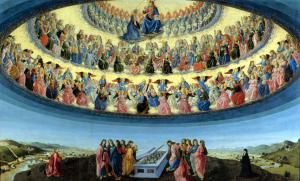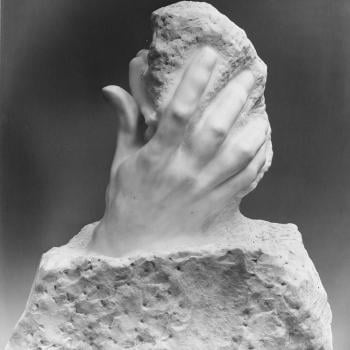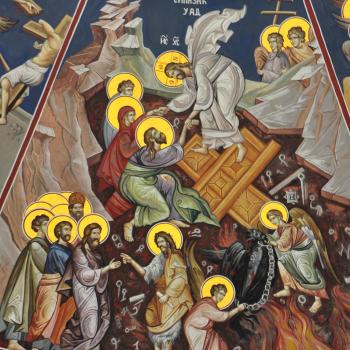
God, who is all good, established his creation so that he could share that goodness with others. But God is infinite and unbounded, while every created being has their own limitations and boundaries. As such, nothing created comes close in comparison to God. God is infinitely greater than anything which he created. Nonetheless, God created a diverse array of beings, each with their own potentiality, and through that potentiality, each has their own way(s) to approach God. Those with greater potential will be able to ascertain and receive more from God than those with lesser potentialities. And the greater the difference between God and some created being, the more God has to veil himself to that created being in order to be approachable by that being, for his great majesty is like a bright light which blinds those who see it if they are not shielded in some fashion.
Hence, it is not unreasonable that God’s light be hidden, that its hiddenness derives from the intensity of its disclosure, and that heedlessness of it stems from the radiance of its brightness. So glory be to Him who is hidden from creatures through the intensity of His manifestation and veiled from them because of the radiance of His light! [1]
God can, and does, condescend to veil himself through many means so that created beings can encounter him and receive his blessings upon them. One of those ways is by allowing his blessings and glory to be shared. That is, those who receive some of his blessings will be able to take what they have received and share it with others so that through them, others can also attain various blessings from God. This means there will be mediators of God’s grace, mediators between his great and incomprehensible nature and particular beings, mediators which receive a share of God’s great glory, but because of their own limited nature, are much more approachable than God himself. They selflessly give of what they have been given to those who have not received what they received, and then likewise, those who receive from these mediators can likewise become mediators and share what they have been given to others as well. Created beings, therefore, can be seen sharing in and reflecting the divine glory; what they offer is mere reflections of that glory, which means it is limited, making it much more accessible and approachable than the absolute glory of God himself.
Each created being, therefore, can be considered a light, though, as Al-Ghazālī explains, they receive their light from others, and none receive it directly from God’s essence except the one which is directly next to his essence. “Other lights are lights derived from the light that is adjacent to Him, not from His Essence.”[2] That is, they receive their light indirectly from God, because none can receive God in his fullness; but all are capable of participating in the all-glorious light of God, which is transformed and veiled in many forms, so that through their participation with it, they become greater than their nature allows: that is, they become deified. They do not become the divine nature, and so will never attain the transcendent glory of God for themselves. They will find themselves rising beyond their created potentiality, becoming more and more like God, and acting more and more like him. They will find themselves sharing more and more of themselves and what they have received from God with others, so as to help others transcend their own potentialities as well. Thus, as Pseudo-Dionysius understood, hierarchies develop so that through them, created beings can be lifted up together and made ever greater: “The goal of a hierarchy, then, is to enable beings to be as like as possible to God and to be at one with him.” [3] Spiritual hierarchies exist for the salvation and elevation of all. Their source is with God, and those within them share what God has given them to others. This means that God continues to be the source, foundation, and goal of all legitimate spiritual hierarchies, though created beings become sources by which God shares his graces because in and through such them, he can veil himself and not confound his creation with his great majesty:
What we must say is this. The blessed Deity which of itself is God, is the source of all divinization. Out of its divine generosity it grants to the divinized the fact of this divinization. It has bestowed hierarchy as a gift to ensure the salvation and divinization of every being endowed with reason and intelligence. [4]
Many different hierarchies exist. Scripture presents, for example, angelic hierarchies, various created beings which have some connection with God and yet share what they have gained from their connection with God with other parts of creation:
All angels bring revelations and tidings of their superiors. The first bring word of the God who is their inspiration, while the others, according to where they are, tell of those inspired by God. For the transcendent harmony of all the world has providentially looked after every being endowed with reason and intelligence and has ensured that they are rightly ordered and sacredly uplifted. [5]
There is likewise, an ecclesial hierarchy, where sacramental graces are shared. This includes the priesthood, which offers the means by which various sacramental graces are made possible. But the church is not limited to the priesthood, nor is the hierarchy found within the various ranks of clergy the only hierarchy available to us. All those who are touched by God, all those who have been rendered holy by grace, realize their potential and are elevated beyond it, establishing a hierarchy of holiness in the world, and they are capable of and will share the grace they have received with others, so that others can likewise participate in that grace and be elevated by it. That is, though the ecclesial hierarchy involved in the sacraments is important, and it is the central means by which grace is shared in such a way that all can receive from it despite the character of the bearer of such grace, it is not the only hierarchy within the church. There is a hierarchy of holiness, which, to be sure, receives grace from the sacraments and is energized by it, but it also transcends it as it takes that grace and uses it to develop a new potential, a new holiness, a new way of being which can then share itself with others and help others ascertain the way of holiness which is necessary for further spiritual development (and with it, their deification). The two hierarchies should work together, but often, they are in conflict with each other, as those within the clerical ranks often do not properly follow grace themselves and so find themselves ranking low on the other hierarchy, while those who rank high with holiness often are not themselves of any clerical rank. The clerical hierarchy is the backbone of the church, but the hierarchy of holiness and grace is what fleshes out the body, and without it, the body will appear decrepit and unhealthily close to spiritual starvation and death.
St. Gregory Palamas reminds us that the origin of this light, this glory, which is spread through various hierarchies, is uncreated and truly said to be God himself. It is not some sort of created other which keeps us distant from God. Even that which is shared through mediation contains this uncreated light, this uncreated glory, so that all who open themselves up to it and receive it receive not merely some secondary being (though they do so as well, because of the mediation which is used to share it), they receive God himself and so truly find themselves communing with God (albeit in a veiled form which they can apprehend). Thus, arguing against those who suggest all that is received is merely some secondary created being, he says:
The divine and inexpressible light, God’s divinity and kingdom, the beauty and resplendence of the divine nature, the vision and delight of the saints in the age without end, the natural ray and glory of the Divinity – this the followers of Akindynos call an apparition and creature. Further, they slanderously call ditheists those who refuse to blaspheme as they do against the divine light and who affirm God to be uncreated both in His essence and in His energy. But they should be ashamed, for though the divine light is uncreated, there is for us one God in one divinity, since as has been shown above in many different ways, both the uncreated essence and the uncreated energy – that is, this divine grace and illumination – pertain to God.[6]
The greatness of God’s deifying grace is that it is capable of being received in many forms, in many different veils, and recognized in and through many different gifts (spoken of by many names, or, as St. Gregory Palamas says, among different uncreated energies). They all flow from the Father, come to us in and through the Son (the “light of the world”), and are spread through various hierarchies, so that by one great and glorious gift, the great Light of God, all things can come into communion with each other and be gathered in by the deifying grace of God:
“Every good endowment and every perfect gift is from above, coming down from the Father of lights.” But there is something more. Inspired by the Father, each procession of the Light spreads itself generously toward us, and, in its power to unify, it stirs us up by lifting us up. It returns us back to the oneness and deifying simplicity of the Father who gathers us in. [7]
Now, it must be said that the mere fact that there is a great and glorious spreading of God’s grace through various hierarchies of being does not mean all hierarchal formations must be recognized as good and true. If some hierarchy does not use its gifts to raise others up, then, insofar as they hinder God’s wonderful desire for his creation, they must be criticized, judged, and either reformed (if possible) or eliminated (if they are incapable of reformation). We must be critical of counterfeit hierarchies. We must recognize how they Satanically imitate divine hierarchies. We must not look to those Satanic imitations use them to deny proper hierarchies. For these counterfeits are established by some evil will for the sake of some evil end. They hinder the spread of God’s grace throughout creation. They take a good, the hierarchy of being and grace, and turn it upside-down to corrupt it. We must not let them turn us away from good spiritual hierarchies. And one of the big differences between the good and the bad is that good hierarchies exist, not for their own sake, not as an ends in and of itself (as counterfeit hierarchies tend to exist), but as the means for lifting us out beyond its confines and into the greater good, establishing the kingdom of God with its all-pervading glory in all and for all, for the good of all. We must, therefore, not seek after hierarchies as ends in and of themselves, but see them as the means by which God will spread his greater glory, so that, even in eternity, with eternal deification, we will find these hierarches are eternalized even if they are relative in value.
[1] Al-Ghazālī, The Niche of Lights. Trans. David Buchman (Provo, UT: Brigham Young University Press, 1998), 23-24.
[2] Al-Ghazālī, The Niche of Lights, 20. From a Christian standpoint, that which is “next to his essence,” is that which has been assumed to the Logos in the hypostatic union, which is why the incarnation is important.
[3] Pseudo-Dionysius, “The Celestial Hierarchy” in Pseudo-Dionysius: The Complete Works. trans. Colm Luibheid (New York: Paulist Press, 1987), 154.
[4] Pseudo-Dionysius, “The Ecclesiastical Hierarchy” in Pseudo-Dionysius: The Complete Works. trans. Colm Luibheid (New York: Paulist Press, 1987), 198.
[5] Pseudo-Dionysius, “The Celestial Hierarchy,” 173.
[6] St. Gregory Palamas, “Topics of Natural and Theological Science and on the Moral and Ascetic Life: One Hundred and Fifty Texts,” in The Philokalia: Volume IV. Trans. and ed. G.E. H. Palmer, Philip Sherrard, Kallistos Ware, et. al. (London: Faber and Faber, 1995), 415 [#147].
[7] Pseudo-Dionysius, “The Celestial Hierarchy,” 145.
Stay in touch! Like A Little Bit of Nothing on Facebook.
If you liked what you read, please consider sharing it with your friends and family!













